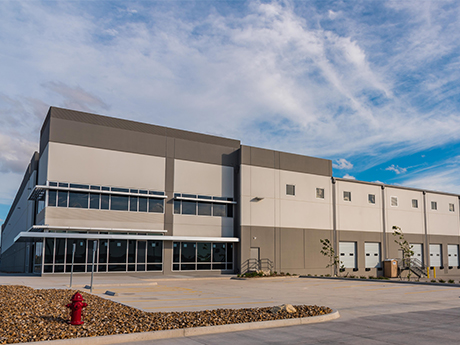By Paige Suvalsky, field research manager — Central Texas, CBRE; Rob Burlingame, senior vice president — Central Texas, CBRE; and Miller Hamrick, Texas industrial & logistics research lead, CBRE
CBRE Research recently profiled Austin and San Antonio as an “emerging” industrial market along the Interstate 35 corridor in Central Texas. This region makes up much of the western portion of the “Texas Triangle”, a mega-region on a global scale that had an economic output of $1.5 trillion in 2021 and a population of just over 20 million people.

Paige Suvalsky, CBRE
The Texas Triangle represents a top 25 global economy, just ahead of Spain. The northern apex of the Texas Triangle, Dallas-Fort Worth (DFW), is projected to surpass Chicago by 2034-2035 to become the third-most populous urban region in the United States with a population of 9.4 million.
This massive boom in population and business is driving the current rush to Central Texas and pushing regional and national developers to stake their claims in this growing market. Currently, about 5.5 million people live between the stretch of Texas from Laredo to Georgetown, and this area’s population is expected to grow by 10.8 percent over the next five years.
According to data from the U.S. Census Bureau, Hays County was the fastest-growing county in the United States between 2010 and 2020, experiencing a 53 percent increase in population during that stretch. Comal County ranked second on the list with a 49 percent increase, followed by Williamson County at fourth with a 44 percent increase.

Rob Burlingame, CBRE
Overall, six of the top 10 fastest-growing U.S. counties were in Texas, and three of those were situated within the I-35 corridor. To accommodate this growth, in the last five years, industrial developers have grown the volume of space within the corridor by nearly 21.4 million square feet, a 17.7 percent increase in total inventory during that five-year period.
The region is home to two major cargo-moving airports: Austin-Bergstrom International Airport, where year-over-year cargo movements grew by 12.1 percent in 2020, and San Antonio International Airport. In response to Austin’s growing economy, Bergstrom airport plans to expand its cargo operations even further and offer direct flights to major cargo hubs in Europe such as Amsterdam-Schiphol, London-Heathrow and Frankfurt (Germany). San Antonio International Airport has also announced plans to upgrade its airfield, terminals and ground access over the next two decades to accompany the numerous connections that it currently offers to Mexico.
In addition to I-35, several major highways cross through the region, including Interstates 37 and 10, which provide direct access to the West and East coasts. I-35 also connects the region with Mexico and Canada, making it a major beneficiary of the USMCA trade agreement.
The region is also home to one of the biggest rail terminals in Texas: East Kelly Railport at Port San Antonio. Port San Antonio is a 1,900-acre industrial hub that includes manufacturers, third-party logistics providers and aerospace defense contractors. In addition, Port San Antonio is part of a Foreign Trade Zone.

Miller Hamrick, CBRE
The past two years have exposed the fragility of global supply chains, and occupiers have responded by realigning their supply networks, which sometimes means an increased need for warehouse space closer to their customers.
Additionally, as COVID-19 cases continue to grow, China is reinstating lockdowns to contain the virus. Shutdowns of factories and ports will undoubtably send ripples through global supply networks and the overall economy. This in turn will underscore the urgency with which companies will need to assess their supply chains as backups could reoccur.
As of late, there has been more and more buzz about “near-shoring,” or creating regional value chains that can hedge against geopolitical or epidemiological events in far-flung parts of the world. Texas, which has already benefited tremendously from changes seen in global supply chains, stands to gain from global value chain realignment to Mexico. This shift will provide a strong labor pool and most importantly, proximity to consumers in the United States. Within the 250-mile span of San Antonio and Austin, occupiers can reach a combined 25.4 million consumers.
While Austin has not traditionally been considered a bulk warehouse market, trends that have spurred demand in larger industrial markets have also resulted in increased demand as companies look to realign their distribution networks and deepen coverage of last-mile delivery services. Consumer goods, e-commerce and manufacturing deals that are related to the anticipated opening of the Tesla Gigafactory primarily drove industrial demand for the first quarter of 2022.
Both Austin and San Antonio are within the Texas-Mexico Automotive Super-Region, an auto manufacturing mega-region that spans from the Bajio in Mexico to North Texas, making it an excellent location for original equipment manufacturer (OEM) suppliers up and down this major transportation artery. While the Gigafactory is a newer development for Texas, Toyota has been building full-size trucks at its San Antonio plant since 2006.
Just 2.5 hours from the U.S.-Mexico Border, San Antonio is very much connected to Mexico culturally and commercially. In fact, Texas companies exported $122.7 billion in goods to Mexico in 2021, which accounted for 32.7 percent of all international exports from Texas. Meanwhile, some $108.4 billion in Mexican imports, which spur demand for warehouse space, went to Texas in 2021, constituting 34.7 percent of all international imports to Texas.
Specifically within the automotive industry, imports of vehicles and parts from Mexico totaled $13.8 billion in 2021, and exports of vehicles and parts to Mexico totaled $7.1 billion.
More retailers, wholesalers and third-party logistics providers are expected to target the I-35 Corridor in coming years. Continued warehouse and manufacturing development along this corridor will eventually merge Austin and San Antonio into one cohesive market. Strong demand will continue to lower vacancy rates and increase rents, making the region very attractive to investors into the foreseeable future.
— This article originally appeared in the May 2022 issue of Texas Real Estate Business magazine.


